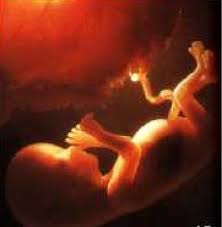It was December, 1989…. just a normal Friday evening at a home in Houston, Texas. Chad Traywick and his wife, Darda, had just driven up in their truck …and found themselves immediately surrounded by police, the SWAT team and a van from the coroner's office.
Chad and Darda were pulled from their vehicle and patted down. They were then informed by Det. John Hill that the police wanted to search the house.
A local photo-finishing store had called police to report they had developed photos from film that Chad had dropped off of a beheaded and mutilated newborn baby.
The police and the SWAT team were prepared to arrest suspected satanic cult members –
Except, upon entering the house, instead evidence of child sacrifice, they found pro-life religious posters and books.
They confronted Chad….his story unfolded.
Chad Traywick had recently become active in the pro-life movement. At 3 o'clock Saturday afternoon he went to the WOMEN’S PAVILION, a local abortion clinic, to determine a location for conducting a picket at the facility.
Chad found that no one was in the building and that the door was open. He went in. The waiting areas were attractive and the operating rooms were quite clean.
But as he continued to explore he came upon a small back room filled with 15 plastic buckets with lids on. He realized what the contents might be and, taking one of the larger buckets, he quickly left.
Darda and a friend videotaped and photographed his opening of the container.
What was inside the bucket was horrifying. The contents appeared to be a full-grown baby boy. His head and right arm had been ripped from his body and his brain removed. The baby had bitten through his own tongue, no doubt while his head, grasped by forceps, was being literally ripped off his body. The baby’s body had an incision where other organs had apparently been removed .
Chad Traywick took the film to a one-hour photo developer. He said, "I explained to them that the pictures were of an aborted baby and asked if they would have any problem or felt uncomfortable developing them."
The clerk said there would be no problem. But when he returned for the developed pictures the clerk was quite nervous. The photographs were so terrible that the clerk had called the police to investigate what appeared to be an appalling crime. The police had only to look at the photos… for them, that was enough.
Once the police had been given his explanation Chad, on December 15th,1989, agreed to make a statement at police headquarters about what had occurred.. He was not the baby’s killer.
A neighbor shared more information. After describing the events surrounding Chad’s arrest, he commented, as he looked at the pictures of Baby David, that this wasn’t the only time he had seen a mutilated baby like this.
He went on to declare that he had once worked for the City of Houston’s water treatment plant. One of his jobs was to clean the screen that filtered the effluent as it came into the facility. Quite often he would remove babies from the screen, particularly on Saturdays (when most abortions are performed). Their ultimate lot, he testified, were to be thrown into a large grinder.
Chad named the baby boy David and on Jan. 20, 1990, he buried him after a memorial service attended by over 100 people. That was 21 years ago.
We are now at the 38th anniversary of the Supreme Court's Roe v. Wade abortion decision and not much has changed. There continue to be babies in buckets… the horror that was revealed this week in Philadelphia gives proof to that.
 |
| Dr. Kermit Gosnell |
I used to believe in a "fundamental constitutional right," "a private decision between a woman and her doctor," "a woman's right to choose" and other noble sounding euphemisms. But then I was confronted with what that "choice" really meant.... Baby David and millions like him….are the result of "choice." ………
Baby David, a 28-week-old ( 7 months) "fetus" aborted at the Women's Pavilion, a Houston, Texas, abortion clinic. He was 16-inches long and underwent a D&E abortion, where limbs are ripped off one by one.
Other babies are scraped, cut up, , vacuumed, ripped apart, and chemically burned (Google the term “candy apple baby”). Some have their skulls crushed and their brains sucked out. One can summon these images on the Internet within seconds. Pieces of baby. I recommend caution…they are not for the faint of heart….and they might …if nothing else…give one a great deal to think about. They just might even make one shift a paradigm.
Consider the many millions of American children of all races and ethnicities… gone… out of our lives in the name of the Constitution, choice and freedom.
This is now a 38 year long struggle. The debate over abortion continues because so many know, in their heart of hearts, that it is not right. And I am convinced that many who continue to support its Constitutionality have never seen the Baby Davids. They have never looked at the contents of the buckets. I know I had not.
I now look forward to the day when we, as a society, declare that these small lives are valuable and that we do not, when our daughters “make a mistake”, consider them, in the words of President Obama, “punished with a baby. "
I am reminded of the gypsy in Verdi's opera Il Trovatore. Outraged by the count's cruel injustice, she stole his infant son and, in a crazed act of vengeance, flung him into the fire.... Or so she thought. For, in turning around, she discovered the count's son lay safe on the ground behind her; it was her own son she had thrown into the flames.
Abortion can present itself as sparkling liberty, a way to cast off the shackles of being female. That illusion lasts only until you realize who it was you threw into the inferno.









































